
"Menorah: Worship, History, Legend" is a 2017 museum exhibition sponsored jointly by the Vatican Museums and the Jewish Museum of Rome. [1]

"Menorah: Worship, History, Legend" is a 2017 museum exhibition sponsored jointly by the Vatican Museums and the Jewish Museum of Rome. [1]
Menorah refers both to the Menorah with eight candleholders and a ninth to hold the "servant" candle used on the Jewish holiday of Chanukah, and to the large, 7-branched solid gold Menorah used in the ancient Jewish Temple in Jerusalem. The original gold menorah from the Jewish Temple in Jerusalem is not on display. [2]
The exhibition features 130 objects, including menorahs and images of menorahs, loaned by 20 museums, including the Louvre and the National Gallery in London. [2] It ran from 15 May through 23 July 2017. [3] [4]

The menorah is a seven-branched candelabrum that is described in the Hebrew Bible and in later ancient sources as having been used in the Tabernacle and in the Temple in Jerusalem. Since ancient times, it has represented the Jewish people and Judaism in both the Land of Israel and the Diaspora, while in modern times it is represented on Israel's national emblem. The symbol has also been found in archaeological artifacts from ancient Samaritan, Christian and Islamic communities.

A synagogue, sometimes referred to by the Yiddish term shul and often used interchangeably with the word temple, is a Jewish house of worship. Synagogues have a place for prayer, where Jews attend religious services or special ceremonies, have rooms for study, social hall(s), administrative and charitable offices, classrooms for religious school and Hebrew school, sometimes Jewish preschools, and often have many places to sit and congregate; display commemorative, historic, or modern artwork throughout; and sometimes have items of some Jewish historical significance or history about the Synagogue itself, on display.
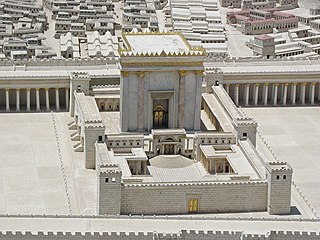
The Second Temple, later known as Herod's Temple, was the reconstructed Temple in Jerusalem between c. 516 BCE and 70 CE. It replaced Solomon's Temple, which is presumed to have been built at the same location before its destruction by the Neo-Babylonian Empire during the Babylonian siege of Jerusalem in c. 587 BCE. Construction on the Second Temple began some time after the Neo-Babylonian Empire was conquered by the Achaemenid Persian Empire; it followed a proclamation by Persian king Cyrus the Great that ended the Babylonian captivity and initiated the return to Zion. In Jewish history, the Second Temple's completion in Persian Judah marks the beginning of the Second Temple period.
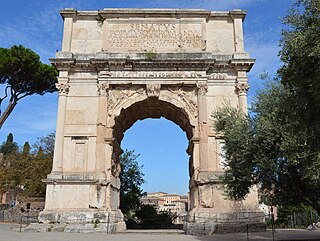
The Arch of Titus is a 1st-century AD honorific arch, located on the Via Sacra, Rome, just to the south-east of the Roman Forum. It was constructed in c. 81 AD by the Emperor Domitian shortly after the death of his older brother Titus to commemorate Titus's official deification or consecratio and the victory of Titus together with their father, Vespasian, over the Jewish rebellion in Judaea.

Magdala was an ancient Jewish city on the shore of the Sea of Galilee, 3 miles (4.8 km) north of Tiberias. In the Babylonian Talmud it is known as Magdala Nunayya, and which some historical geographers think may refer to Tarichaea, literally the place of processing fish. It is believed to be the birthplace of Mary Magdalene. Until the 1948 Arab–Israeli War, a small Palestinian Arab village, al-Majdal, stood at the site of ancient Magdala, while nowadays the modern Israeli municipality of Migdal extends to the area.
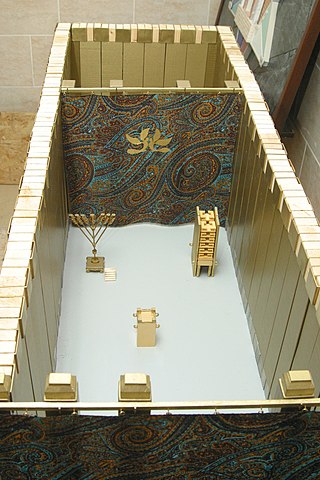
The Holy of Holies is a term in the Hebrew Bible that refers to the inner sanctuary of the Tabernacle, where God's presence appeared. According to Hebrew tradition, the area was defined by four pillars that held up the veil of the covering, under which the Ark of the Covenant was held above the floor. According to the Hebrew scripture, the Ark contained the Ten Commandments, which were given by God to Moses on Mount Sinai. The Temple in Jerusalem was said to have been built by King Solomon for keeping the Ark.
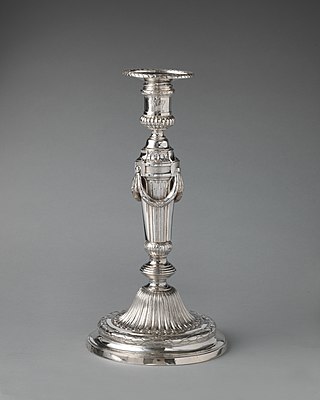
A candlestick is a device used to hold a candle in place. Candlesticks have a cup or a spike ("pricket") or both to keep the candle in place. Candlesticks are less frequently called "candleholders".
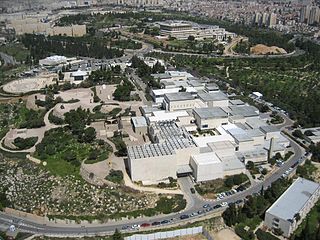
The Israel Museum is an art and archaeological museum in Jerusalem. It was established in 1965 as Israel's largest and foremost cultural institution, and one of the world’s leading encyclopaedic museums. It is situated on a hill in the Givat Ram neighborhood of Jerusalem, adjacent to the Bible Lands Museum, the Knesset, the Israeli Supreme Court, and the Hebrew University of Jerusalem.

A Hanukkah menorah, or hanukkiah, is a nine-branched candelabrum lit during the eight-day Jewish holiday of Hanukkah. Eight of the nine branches hold lights that symbolize the eight nights of the holiday; on each night, one more light is lit than the previous night, until on the final night all eight branches are ignited. The ninth branch holds a candle, called the shamash, which is used to light the other eight.

The Jewish Museum London is a museum of British Jewish life, history and identity. The museum is situated in Camden Town in the London Borough of Camden, North London. It is a place for people of all faiths to explore Jewish history, culture, and heritage. The museum has a dedicated education team, with a programme for schools, community groups and families. Charles III is a patron of the museum.

Ze’ev Raban (22 September 1890 – 19 January 1970), born Wolf Rawicki (Ravitzki), was a leading painter, decorative artist, and industrial designer of the Bezalel school style, and was one of the founders of the Israeli art world.

The Academy Museum of Motion Pictures is a museum in Los Angeles, California constructed by the Academy of Motion Picture Arts and Sciences (AMPAS), which is devoted to the history, science, and cultural impact of the film industry. It is the first large-scale museum of its kind in the United States. The museum is located in the historic May Company Building on the intersection Wilshire Boulevard and Fairfax Avenue, part of Museum Row on the Miracle Mile.
The Yeshiva University Center for Israel Studies reflects the longstanding relationship between Yeshiva University and Israel. It supports research, conferences, publications, museum exhibitions, public programs and educational opportunities that enhance awareness and study of Israel in all of its complexities. The center is led by Director Steven Fine, Professor of Jewish History at Yeshiva University, and Associate Director Joshua Karlip, Professor of Jewish History at Yeshiva University.

Steven Fine is a historian of Judaism in the Greco-Roman World and a professor at Yeshiva University.

The Migdal Synagogue or Magdala Synagogue is the name used for the first of two ancient synagogues discovered at the ancient city of Magdala in Israel, close to the shore of the Sea of Galilee. Both synagogues were in use in the Second Temple period, which places them among the oldest synagogues found in Israel.
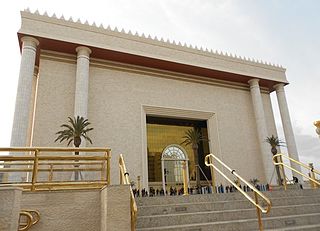
The Temple of Solomon is a replica of the Temple of Solomon built by the Universal Church of the Kingdom of God (UCKG) in São Paulo.
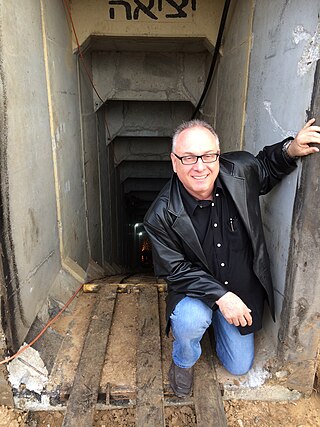
Sam Philipe is an Israeli sculptor. He is known for his sculptures of biblical and New Testament figures.

The Magdala stone is a carved stone block unearthed by archaeologists in the Migdal Synagogue in Israel, dating to before the destruction of the Second Temple in Jerusalem in the year 70.
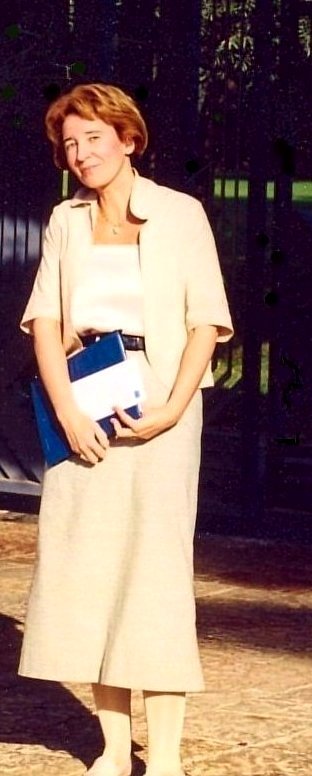
Joanna Angelett is the artist name of Joanna Trummer, a British-Australian jewellery designer, author, founder of the worldwide anti-racism Tree of Life art project. As a designer she is best known for her sculpture-like jewellery, and as creator of desktop items of precious metals, decorated with gems and cloisonné enamels.
Joel Arthur Rosenthal is an American jeweller who works in Paris where he founded the fine jewelry firm JAR. He has been called "the Faberge of our time."